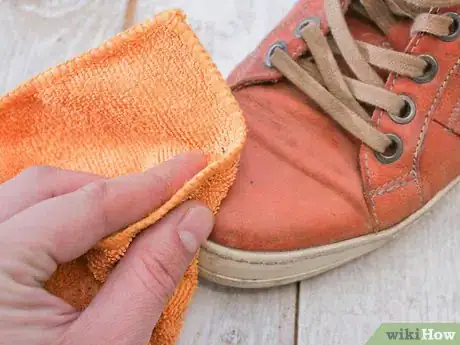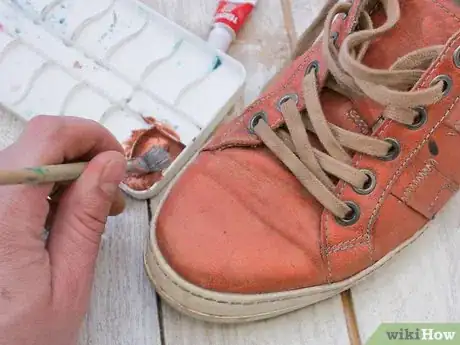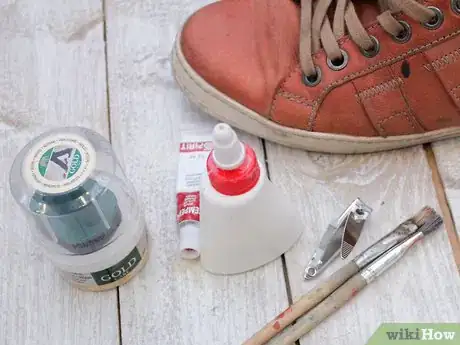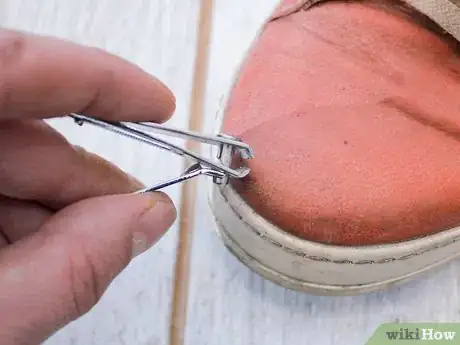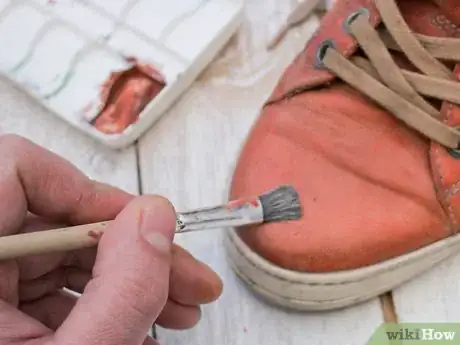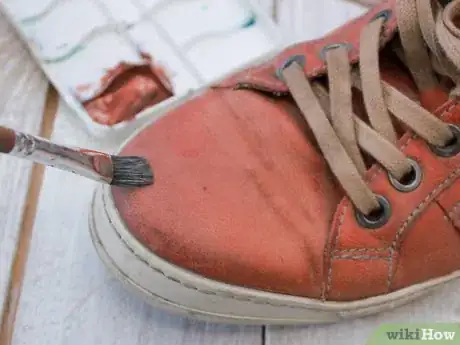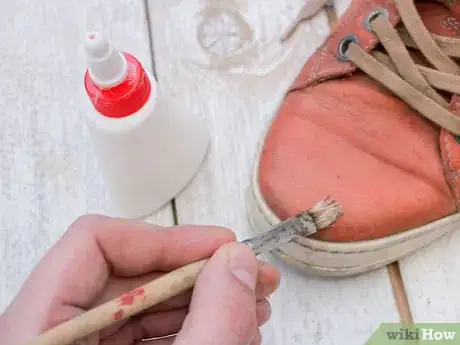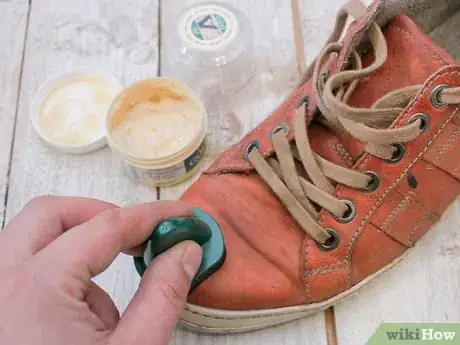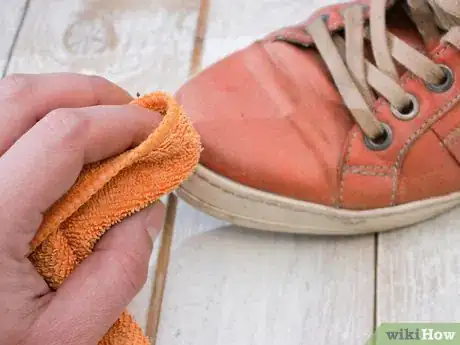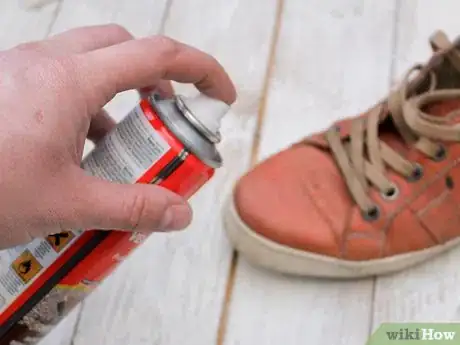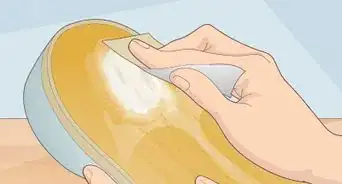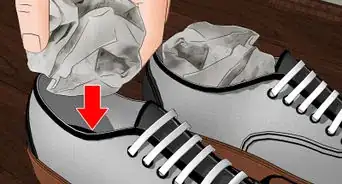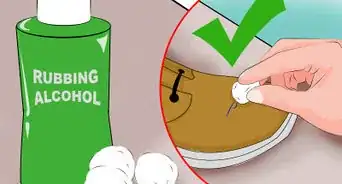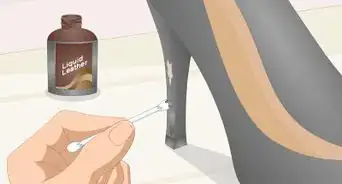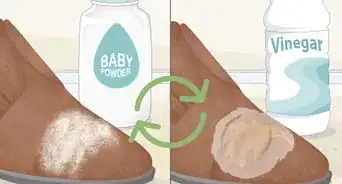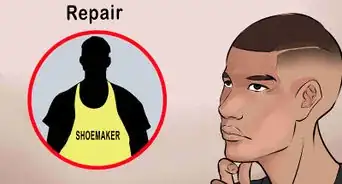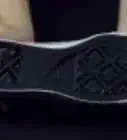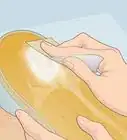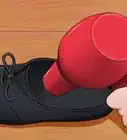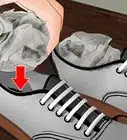This article was co-authored by Mallika Sharma. Mallika Sharma is a Certified Leather Care Technician and the Founder of The Leather Laundry, a niche spa service for luxury leather gear in India. Mallika specializes in leather cleaning, coloring, repairing, and restoring for shoes, handbags, jackets, wallets, belts, and sofas. She holds a Master’s degree in Finance and Investment from the University of Edinburgh Business School. Mallika is a certified Professional Leather Care Technician and trained with the globally reputed leather care company, LTT in the United Kingdom.
This article has been viewed 316,782 times.
Faux leather shoes are a cheap, good-looking alternative to real leather shoes. Though typically more durable than their animal-based siblings, they are not immune to damage, and scrapes or scratches can make them look unsightly. Luckily, with a bit of do-it-yourself magic, you can make your shoes look as good as new.
Steps
Cleaning and Testing the Area
-
1Wipe down the area with a soft cloth and warm water. Then dab the area with a little distilled white vinegar. Treat a small part of the affected area with the vinegar.
- Take a small dab of distilled white vinegar on a paper towel and apply it to an area around the scratch.
- The vinegar may cause the area to slightly swell. The faux leather will cover some of the scratches. The vinegar will also remove any stains like salt, cleaning the area. [1]
-
2Buff the area with a colorless shoe polish. After you clean your shoes and apply the vinegar, wait until the area has dried. Then buff it out with a clear shoe polish or filler cream.
- Apply the polish in a circular motion to spread it evenly over the area. Use medium pressure to evenly distribute the polish without harming the shoe.
- The clear shoe polish will not affect any of your shoe’s color. The buffing will help blend the affected and unaffected areas together.
Advertisement -
3Pick up some acrylic paint that matches the color of your shoes. Take your shoe or boot to a home improvement or craft store and match the color of paint to your shoe color.
- You can buy paint in a variety of finishes. Try to match the sheen of your shoe as best you can with flat, eggshell, or glossy paint. Acrylic paint works best for painting your scratches and scrapes.
-
4Buy a bottle of Modge Podge and or Shoe Goo at a craft store. Again, try to match the sheen of your shoe as closely as possible by getting matte, satin, or glossy Modge Podge.
- Modge Podge is an all-in-one sort of glue, sealer, and finish. You can use it on a variety of crafting projects. But it also works well for treating faux leather shoes.
- Shoe Goo is a similar product that has a variety of shoe-related purposes. Shoe Goo can be used to glue, seal, and finish as well. Shoe Goo is essentially rubber in a tube. Once it is applied and dried, it becomes a strong, flexible rubbery material. It will dry clear as well. [2]
- Depending on the damage you are trying to repair, you may find one to be better than the other. Or, you may want to use both.
-
5Apply a small bit of your paint to the scratched area. You should dab just a bit of paint once the polish has dried to a more hidden area to test how the paint looks on your shoe.
- Dabbing a small bit of paint to test-treat the area will allow you to make sure that the paint color blends well with the color of your shoes. If it does, you’re ready to continue.
Treating the Area
-
1Gather all your repairing materials. You will now need your Modge Podge and or Shoe Goo, paint, paint brushes, small container for paint, paper towels, shoe polish, shoe spray, and a nail clipper or fine-grain sandpaper.
- You will want to use a small paintbrush so you only paint the scratches and not the larger area around the scratches.
- You can use a nail clipper or fine-grain sandpaper to remove any loose material around your scratches. Nail clippers will allow you to be more precise. Sandpaper may be better for larger areas that are closer to the sole of your shoes or boots. [3]
-
2Use a nail clipper to clip off any material that is sticking out or hanging off the shoe. Your faux leather shoes or boots may have small flakes around your scratches. You want to remove these loose bits so you can cover up the scratch and not just press the broken flecks down. The area should be a smooth as possible.
- Again, nail clippers or even tweezers will allow you to remove any material in a specific area. However, if you have a larger area that needs to be repaired, the sandpaper will be more effective at smoothing these larger areas out.
-
3Paint carefully over the sections that need to be repaired. With your shoes wiped down again and free of any excess material, it’s time to paint the scratches.
- Using your small paintbrush, dip the tip into your container holding your paint. You don’t need a lot. Less is better so you don’t cause the paint to transfer unevenly.
- Paint the scratches with smooth strokes. Let it sit for a minute or so. Wipe your brush on your paper towel to remove clumped paint.
-
4Let the paint dry and add another coat if needed. Repeat the process adding another coat using a little bit of paint at a time.
- Keep applying new coats until you have painted the scratches to your liking.
- Make sure to only use a small amount of paint with each coat. If the paint globs together you will end up with bubbles of paint on your shoes. Making the affected areas look uneven.
Protecting the Area and Your Shoes
-
1Apply the Modge Podge or Shoe Goo. After the paint is fully dry, use a very light coat of Modge Podge or Shoe Goo and paint over the general area to seal it.
- It’s best to use a different paint brush when applying the Modge Podge or Shoe Goo. If you are only using one brush, make sure to rinse it well and wipe off any paint with a paper towel before using it.
- After you’ve applied the Modge Podge or Shoe Goo, wipe the brush on a piece of paper to get all the excess off. Then use the brush to carefully feather the edges of your painted area so that you don’t have any visible lines.
- Shoe Goo is typically clear while Modge Podge paints on white. Don’t worry if the treatment has a color to it when painting on. Once it dries it will dry clear.
-
2Polish your shoes with shoe polish. Once everything is dry, give your shoes or boots a good polish with the correct color polish to match your shoe.
- Polishing your shoes will help to fully blend all the areas of the shoe. Polish will smooth out any areas around your scratches that still stand out. As well as give your shoes a fresh look.
- Depending on the severity of your scratches, you may want to apply polish after your paint but before you seal the areas. Polishing the scratched area and then sealing will make the polish under your sealant more permanent.
-
3Clean up any other areas of your shoes or boots. Once you’ve treated the scratches, clean up any other areas that may still be dirty or need some work. If you have to wipe down most of your shoes, do so before polishing the entire shoe. Clean the rest of your shoes using the same method as before, with a clean cloth, water, and a little bit of white vinegar if you have salt or dirt you are trying to remove.
- Admire your awesome work by completely cleaning your shoes so that your pair looks as good as new.
- Let everything dry completely before wearing your shoes. If you wear your shoes or boots before letting everything set and dry you could cause cracks and scratches to reopen.
-
4Spray and protect your shoes with waterproof spray. Go the extra step and give your shoes or boots one more element of protection.
- Use a waterproof spray and or shoe lube wax to protect your shoes from salt stains, water, and dirt.
- This extra protective step will help to keep the treated areas from showing again. It will also prevent new areas from becoming as damaged.
- If you spray your shoes, do so in a ventilated area.
- Make sure that whatever spray or lube you are using is suitable for your faux leather shoes.
Warnings
- Be careful not to get lint or hair stuck in the Modge Podge while it's drying. Once it's dry, it's permanent.⧼thumbs_response⧽
Things You'll Need
- Color-matched paint
- Modge Podge or Shoe Goo
- Small paintbrush(s)
- Paper towels, newspaper
- Nail clippers or fine-grain sandpaper
- Shoe polishes and protective lube or spray
References
About This Article
To easily remove a scrape from a faux leather shoe, wipe the affected area with a soft cloth and warm water, then dab it with a small amount of distilled white vinegar. The vinegar might cause the faux leather to swell as it covers up the scrape -- to fix this, simply buff the shoe with colorless shoe polish, using circular motions to spread it out evenly. For tips on removing more stubborn stains, read on!
